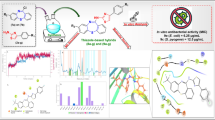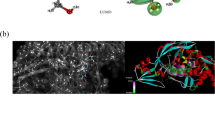Abstract
The increasing occurrence of drug-resistant bacterial infections in the clinic has created a need for new antibacterial agents. Natural products have historically been a rich source of both antibiotics and lead compounds for new antibacterial agents. The natural product simocyclinone D8 (SD8) has been reported to inhibit DNA gyrase, a validated antibacterial drug target, by a unique catalytic inhibition mechanism of action. In this work, we have used a deconstruction-reconstruction approach to prepare analogs of the coumarin subunit of SD8 and evaluated their ability to disrupt binding of the DNA gyrase enzyme to DNA in a surface plasmon resonance assay. This has led to a minimum pharmacophore required for disruption of binding.








Similar content being viewed by others
References
Bax BD, Chan PF, Eggleston DS, Fosberry A, Gentry DR, Gorrec F, Giordano I, Hann MM, Hennessy A, Hibbs M, Jianzhong H, Jones E, Jones J, Brown KK, Lewis CJ, May EW, Saunders MR, Singh O, Spitzfaden CE, Shen C (2010) Type IIA topoisomerase inhibition by a new class of antibacterial agents. Nature 466:935–940
Boucher HW, Talbot GH, Bradley JS, Edwards JE, Gilbert D, Rice LB, Scheld M, Spellberg B, Bartlett J (2009) Bad bugs, no drugs: no ESKAPE! an update from the infectious diseases society of America. Clin Infect Dis 48:1–12
Brown SD, Farrell DJ, Morrissey I (2004) Prevalence and molecular analysis of macrolide and fluoroquinolone resistance among isolates of streptococcus pneumoniae collected during the 2000–2001 PROTEKT US Study. J Clin Microbiol 42:4980–4987
Devasia RA, Blackman A, Gebretsadik T, Griffin M, Shintani A, May C, Smith T, Hooper N, Maruri F, Warkentin J, Mitchel E, Sterling TR (2009) Fluoroquinolone resistance in mycobacterium tuberculosis: the effect of duration and timing of fluoroquinolone exposure. Am J Respir Crit Care Med 180:365–370
Edwards MJ, Flatman RH, Mitchenall LA, Stevenson CEM, Le TBK, Clarke TA, McKay AR, Fiedler H-P, Buttner MJ, Lawson DM, Maxwell A (2009) A crystal structure of the bifunctional antibiotic simocyclinone D8, bound to DNA gyrase. Science 326:1415–1418
Flatman RH, Howells AJ, Heide L, Fiedler H-P, Maxwell A (2005) Simocyclinone D8, an inhibitor of DNA gyrase with a novel mode of action. Antimicrob Agents Chemother 49:1093–1100
Jones D (2010) The antibacterial lead discovery challenge. Nat Rev Drug Discov 9:751–752
Jung S-H, Cho S-H, Hung Dang T, Lee J-H, Ju J-H, Kim M-K, Lee S-H, Ryu J-C, Kim Y (2003) Structural requirement of isoflavonones for the inhibitory activity of interleukin-5. Eur J Med Chem 38:537–545
Kudale AA, Kendall J, Warford CC, Wilkins ND, Bodwell GJ (2007) Hydrolysis-free synthesis of 3-aminocoumarins. Tetrahedron Lett 48:5077–5080
Martínez JL (2012) The antibiotic resistome: challenge and opportunity for therapeutic intervention. Future Med Chem 4:347–359
Maxwell A (1997) DNA gyrase as a drug target. Trends Microbiol 5:102–109
Newman DJ, Cragg GM (2007) Natural products as sources of new drugs over the last 25 years. J Nat Prod 70:461–477
Oppegard LM, Hamann BL, Streck KR, Ellis KC, Fiedler H-P, Khodursky AB, Hiasa H (2009) In vivo and in vitro patterns of the activity of simocyclinone D8, an angucyclinone antibiotic from streptomyces antibioticus. Antimicrob Agents Chemother 53:2110–2119
Pérez-Vázquez M, Román F, García-Cobos S, Campos J (2007) Fluoroquinolone resistance in haemophilus influenzae is associated with hypermutability. Antimicrob Agents Chemother 51:1566–1569
Reinhardt A, Köhler T, Wood P, Rohner P, Dumas J-L, Ricou B, van Delden C (2007) Development and persistence of antimicrobial resistance in pseudomonas aeruginosa: a longitudinal observation in mechanically ventilated patients. Antimicrob Agents Chemother 51:1341–1350
Wright GD (2012) Antibiotics: a new hope. Chem Biol 19:3–10
Yu XM, Shen G, Neckers L, Blake H, Holzbeierlein J, Cronk B, Blagg BSJ (2005) Hsp90 inhibitors identified from a library of novobiocin analogues. J Am Chem Soc 127:12778–12779
Acknowledgments
Funding for this work was provided by the VCU/MCV A.D. Williams Trust Fund, the Thomas F. and Kate Miller Jeffress Memorial Trust Fund, and the VCU School of Pharmacy (to K.C.E.). The author thanks Professor Richard A. Glennon, Professor B. Frank Gupton, and Professor John C. Hackett for helpful discussions and Professor Glen Kellogg for assistance in preparing this manuscript.
Author information
Authors and Affiliations
Corresponding author
Rights and permissions
About this article
Cite this article
Gaskell, L.M., Nguyen, T. & Ellis, K.C. Defining a minimum pharmacophore for simocyclinone D8 disruption of DNA gyrase binding to DNA. Med Chem Res 23, 3632–3643 (2014). https://doi.org/10.1007/s00044-014-0942-z
Received:
Accepted:
Published:
Issue Date:
DOI: https://doi.org/10.1007/s00044-014-0942-z




